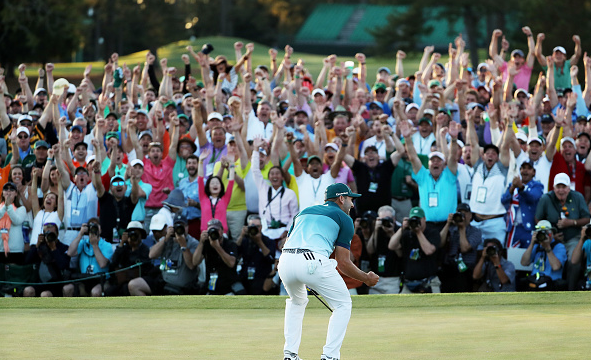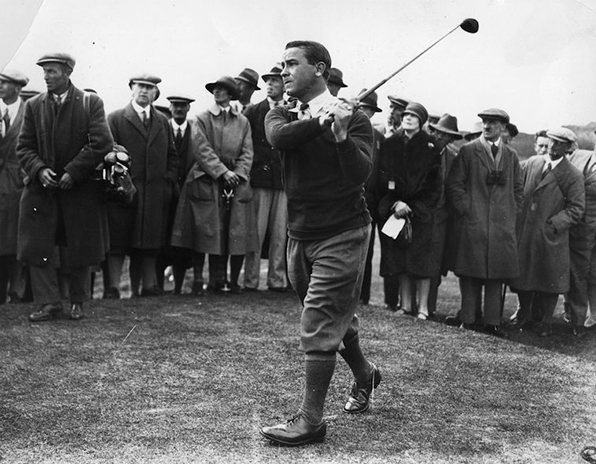
There are no guarantees in sports, except one. The azaleas will always be in bloom in Augusta, Ga., during Masters week. The club makes sure of that.

The Masters, though, also offers as close to a guarantee regarding competition as any sporting event anywhere delivers. With uncanny regularity, it produces moments of the highest drama in sports.
The list is almost endless:
Gene Sarazen’s double-eagle on 15 — “the shot heard round the world” — that set up his victory in 1935. An era of multiple victories each by golf royalty — Byron Nelson, Ben Hogan and Sam Snead.
Arnold Palmer’s ascendancy to being known simply as “the King,” fueled by four green jackets in seven years. Jack Nicklaus then coming along and topping Palmer by winning a mind-boggling six Masters, the last in 1986 as the oldest winner at age 46, fueled by rallying to shoot a magical 30 on the final nine.
Augusta-native Larry Mize’s miracle 140-foot chip-in in 1987 to stun Greg Norman in a playoff. Nick Faldo winning in consecutive years (1989, ’90), both times in playoffs. Ben Crenshaw’s courageous one-stroke win in 1995, when he sank the final putt and broke down crying, remembering his mentor, Harvey Penick, who had died seven days earlier.
Then Tiger Woods, so much Tiger. At 21, he won his first Masters in awe-inspiring form in 1997 — by 12 strokes, the largest margin in Masters history. Tiger’s second green jacket in 2001, completing his “Tiger Slam” as the holder of all four major titles at one time. A third title in 2002, and then the capper in 2005, the chip on 16 that climbed up a slope and then crawled down a hill, stopping to sit on the lip of the cup for two full seconds, then falling in for a birdie greeted with roars that still may be echoing today. (It still took a playoff after that, with a Tiger birdie edging out Chris DeMarco on the first extra hole.)

Could there be more? Of course! Phil Mickelson breaking through to finally win his first major at Augusta in 2004, and then Phil’s audacious gamble (Is there any other way with Phil?) of hitting off the pine straw through the trees on 13 in 2010 to three feet from the cup, on his way to his third green jacket.
Rory McIlroy at 21 in 2011, looking like he would be the next alpha dog in golf as he took the lead onto the 10th tee on Sunday, only to melt down on the back, opening the door for Charl Schwartzel’s victory.
Bubba Watson and Louis Oosthuizen in a playoff in 2012, set up in part by Oosthuizen earlier in the day becoming the first player in Masters’ history to double-eagle the No. 2 hole, but Bubba claiming the title with his own miracle on the second playoff hole, a sweeping hook off of pine straw from deep in the forest that somehow found its way to within 10 feet of the cup on No. 10. Back to No. 10 in a playoff in 2013, Adam Scott making a 12-foot birdie putt to win his first major and become the first Australian to win The Masters.
Bubba winning again in 2014, this time by three shots after being tied for the lead after 54 holes by 20-year-old Jordan Spieth, who finished tied for second. Spieth coming back the next year and leaving no doubt, winning The Masters as the second-youngest champ by setting a record for most birdies and tying Tiger’s record for lowest winning total at 18-under par.

And Sergio Garcia, for the first time, successfully navigated the tightrope between glory and disaster, edging Justin Rose in yet another playoff by sinking a 12-foot birdie putt on No. 18 to claim his first major championship at age 37 in 2017.
It’s almost exhausting to all take in, and yet, every golf fan — every sports fan, really — knows there is likely to be another unreal chapter added on Sunday, April 14, 2019.
The collection of potential storylines is as rich and deep as any in memory.
Will Tiger finally claim major No. 15 to complete his remarkable recovery? Will world No. 1 Dustin Johnson finally break through in Georgia? Can Rory claim the career grand slam in his last start at Augusta as a 20-something? Is it Justin Thomas’ time?
How about Justin Rose, as hot as any golfer and with a strong Masters record that includes two runner-up finishes, but no green jackets?
Will the safe space of Augusta National allow Spieth to get his game back on track?
The answers await us all, beginning on Thursday. It’s bound to be magic.
THE SKINNY
Tournament: The Masters
Dates: April 11-14, 2019
Where: Augusta, Ga.
Course: Augusta National
Distance: Par 72, 7,435 yards
Architect: Alister McKenzie, Bobby Jones
Format: 72-holes, stroke play, 36-hole cut
Purse: $11,000,000
Winning Share: $1,980,000
Defending Champion: Patrick Reed
BROADCAST COVERAGE
All Online coverage at Masters.com. O=Online, CBSSN=CBS Sports Network
MONDAY
On the Range: 12-2:00 pm (O)
Hole No. 16: 12-5:00 pm (O)
—
On the Range: 12-2:00 pm (CBSNN)
TUESDAY
On the Range: 9-11:00 am (O)
Hole No. 16: 12-5:00 pm (O)
—
On the Range: 9-11:00 am (CBSSN)
WEDNESDAY
On the Range: 9-11:00 am (O)
Par-3 Contest: 2-5:00 pm (O)
—
On the Range: 9-11:00 am (CBSSN)
Par-3 Contest: 3-5:00 pm (ESPN)
THURSDAY
Honorary Starter: 7:45-8:45 am (O)
On the Range: 8:30-10:30 am (O)
Featured Groups: 10:00-7:30 pm (O)
Amen Corner: 10:45-6:00 pm (O)
Holes 15 & 16: 11:45-7:00 pm (O)
Broadcast Simulcast: 3:00-7:30 pm (O)
—
On the Range: 11:00-1:00 pm (CBSSN)
Broadcast: 3:00-7:30 pm (ESPN)
Day-One Highlights: 11:30-11:45 (CBS)
FRIDAY
On the Range: 8:30-10:30 am (O)
Featured Groups: 10:00-7:30 pm (O)
Amen Corner: 10:45-6:00 pm (O)
Holes 15 & 16: 11:45-7:00 pm (O)
Broadcast Simulcast: 3:00-7:30 pm (O)
—
On the Range: 11:00-1:00 pm (CBSSN)
Broadcast: 3:00-7:30 pm (ESPN)
Day-Two Highlights: 11:30-11:45 (CBS)
SATURDAY
On the Range: 11:00-1:00 pm (O)
Featured Groups: 10:15-7:00 pm (O)
Amen Corner: 12:30-6:00 pm (O)
Holes 15 & 16: 1:30-6:30 pm (O)
Broadcast Simulcast: 3:00-7:00 pm (O)
—
On the Range: 11:00-1:00 pm (CBSSN)
Broadcast: 3:00-7:30 pm (CBS)
SUNDAY
Featured Groups: 10:45-7:00 pm (O)
On the Range: 11:00-1:00 pm (O)
Amen Corner: 12:00-6:00 pm (O)
Holes 15 & 16: 1:00-6:30 pm (O)
Broadcast Simulcast: 2:00-7:00 pm (O)
Green Jacket Ceremony: 7:00 pm (O)
—
On the Range: 11:00-1:00 pm (CBSSN)
Broadcast: 2:00-7:00 pm (CBS)
LINKS: Web | Instagram | Twitter | Facebook | Wikipedia
HISTORY
Believe it or not, The Masters has not always been called The Masters, at least not officially.
Tournament co-founder Clifford Roberts wanted that name to be attached to the tournament right off the bat, but he was overruled by the legendary Bobby Jones, a paragon of humility, thought the name sounded boastful and pretentious.

As a result, the initial tournaments were given the prosaic name, Augusta National Invitation Tournament, but after five years, the tournament had become such a resounding success that Jones finally relented and allowed the event to officially be called The Masters.
The Masters began as an idea in the mind of Bobby Jones, who had achieved basically everything that could be achieved in golf. He wanted to build his own course, and hold his own tournament. He wanted to create the ultimate golf experience.
After Jones made the decision to build the course in Augusta, Georgia, he and Roberts found an old tree nursery that they felt would be the perfect place. Augusta National was created at that very spot, with help from renowned golf architect Alister MacKenzie.
The inaugural Masters teed off in 1934, with Horton Smith becoming the first champion. What helped the Masters really take off, however, was Gene Sarazen’s double-eagle on 15 on Sunday in 1935, known today as “the shot heard around the world”.
Sarazen would go on to win that Masters in a playoff, and it soon built a reputation for being high-end tournament worthy of the best of the best.
Over the years, the course and tournament format have been frequently updated, and many traditions were adopted. One such tradition, the green jacket, was originally just for club members, but the decision was made to make each year’s tournament winner an honorary Augusta member, and award them their own green jacket.

Other traditions include medals for winners and runner-ups, honorary tournament starters, the annual par-3 tournament and the Champion’s dinner, a feast hosted (and paid for) by the previous year’s winner.
Tournament winners have included many of the all-time greats, including Sarazen, Ben Hogan, Byron Nelson, Sam Snead, Arnold Palmer, Jack Nicklaus, Gary Player, Tom Watson, and Tiger Woods, among many others. Nicklaus holds the tournament record with six green jackets, followed by Palmer and Woods with four apiece.
Woods’ first Masters win (1997) was by an unfathomable 12 strokes, a tournament record. Jimmy Demaret, Snead, Player, Nick Faldo, and Phil Mickelson are three-time winners, while Horton Smith, Nelson, Hogan, Tom Watson, Seve Ballesteros, Bernhard Langer, Ben Crenshaw, Jose Maria Olazabal, and Bubba Watson have won twice. The winner is famously given a lifetime Masters exemption.
HISTORY: RECENT WINNERS
2018: Patrick Reed (-15)
2017: Sergio Garcia (-9)
2016: Danny Willett (-5)
2015: Jordan Spieth (-18)
2014: Bubba Watson (-8)
2013: Adam Scott (-9)
2012: Bubba Watson (-10)
2011: Charl Schwartzel (-14)
HISTORY: RECORDS
SCORING:
270 (-18) Tiger Woods (1997), Jordan Spieth (2015)
WINS:
6 – Jack Nicklaus (1963, 1965-66, 1972, 1975, 1986)
4 – Arnold Palmer (1958, 1960, 1962, 1964)
4 – Tiger Woods (1997, 2001-02, 2005)
3 – Jimmy Demaret (1940, 1947, 1950)
3 – Sam Snead (1949, 1952, 1954)
3 – Gary Player (1961, 1974, 1978)
3 – Nick Faldo (1989-90, 1996)
3 – Phil Mickelson (2004, 2006, 2010)
THE COURSE
Augusta National Golf Club, located in the Georgia town of the same name, is one of the most famous golf clubs in the world.
Founded by Bobby Jones and Clifford Roberts on the site of the former Fruitlands Nursery, the course was designed by Jones and Alister MacKenzie, and opened for play in January 1933.

Since 1934, the club has played host to the annual Masters Tournament, one of the four major championships in professional golf, and the only major played each year at the same course.
Lengthened in recent years because of the increasing number of big hitters, the course still makes mortals of most.
Amen Corner
The second shot at the 11th, all of the 12th, and the first two shots at the 13th hole at Augusta are nicknamed “Amen Corner”. This term was first used in print by author Herbert Warren Wind in his April 21, 1958, Sports Illustrated article about the Masters that year. Wind said he wanted a catchy phrase like baseball’s “hot-corner” or football’s “coffin-corner” to explain where some of the most exciting golf had taken place. Thus “Amen Corner” was born.
Famous Moments: In 1958 Arnold Palmer outlasted Ken Venturi to win the tournament with heroic escapes at Amen Corner. Amen Corner also played host to Masters moments such as Byron Nelson’s birdie-eagle at 12 and 13 in 1937, and Sam Snead’s water save at 12 in 1949 that sparked him to victory.
On the flip side of fate, Jordan Spieth’s quadruple bogey on No. 12 during Sunday’s final round in 2016 cost him his 2-stroke lead and ultimately the championship.
Ike’s Pond
During a visit to Augusta National, then-General Eisenhower returned from a walk through the woods on the eastern part of the grounds, and informed Clifford Roberts that he had found a perfect place to build a dam if the club would like a fish pond.
Ike’s Pond was built and named, and the dam is located just where Eisenhower said it should be. This is also the location that Roberts committed suicide by gunshot in 1977. At age 83, he had been in ill health for several months with cancer and had a debilitating stroke.
Rae’s Creek
Rae’s Creek cuts across the southeastern corner of the Augusta National property. It flows along the back of the 11th green, in front of the 12th green, and ahead of the 13th tee. This is the lowest point in elevation of the course.
The Hogan and Nelson Bridges cross the creek after the 12th and 13th tee boxes, respectively. The creek was named after former property owner John Rae, who died in 1789.
Rae’s Creek runs in front of No. 12 green, has a tributary evident at No. 13 tee, and flows at the back of No. 11 green. It was Rae’s house which was the farthest fortress up the Savannah River from Fort Augusta. The house kept residents safe during Indian attacks when the fort was out of reach.
View PGW’s hole-by-hole course preview here.
DEFENDING CHAMPION
Patrick Reed was ripped mercilessly by fans and media for referring to himself as a top-5 player in the world several years ago.
Now, the famously-cocky 27-year-old has some hardware to give exceptional credence to his argument: a green jacket.

Starting the day at 14-under-par with a three-stroke advantage, Reed was not quite as brilliant as he had been in the opening three rounds, but he was good enough.
Despite the newness of owning the pole position at a major, Reed held the lead like a veteran, holding off an early charge from four-time major champion Rory McIlroy, and furious late charges from Augusta savant Jordan Spieth and major-desperate Rickie Fowler, to shoot a 1-under 71 and become the fourth straight player to make The Masters their first career major.
FINAL TOP 5
1 Patrick Reed -15
2 Rickie Fowler -14
3 Jordan Spieth -13
4 Jon Rahm -11
5 Cameron Smith -9
5 Bubba Watson -9
5 Henrik Stenson -9
5 Rory McIlroy -9
THE FIELD
Like last year, the field for this edition includes just 86 players — the co-smallest in 21 years — but it is mighty.
The collection of star power who can realistically entertain hopes of being swathed in a nice, new green jacket on Sunday evening feels almost like a once-in-a-generation gathering.

Breaking them into age categories, we have the “young guns” such as world No. 5 Justin Thomas (25), world No. 8 Jon Rahm (24), and Xander Schauffele, a 25-year old who’s ranked 10th in the world. And, despite form that has left many perplexed, 25-year old Jordan Spieth, the 2015 Masters winner, is always a threat at Augusta National.
Then you have a pair of “Young Guns,” who are getting just a bit older, but have won multiple majors, including three-time major winner Brooks Koepka (28), and four-time major champion Rory McIlroy, who would complete a career grand slam with a Masters title at age 29.
Next you move to a strong group of players in the prime of their careers, between ages 30-40. World No. 1 Justin Rose, at age 38, is perhaps the most conspicuous player not to have won a Masters title, having finished second twice in the last four years. Dustin Johnson, the world’s No. 2 player, who was born only 75 miles from Augusta in Columbia, S.C., is still looking for his first Masters title at age 34, but has his only two top 10 finishes in the last two Masters he’s played.
World No. 9 Rickie Fowler, who recently turned 30, is still looking for his maiden major title, while world No. 14 Jason Day, 31, is another top star to watch.

Finally, you have the 40-somethings showing sparks of magic — Phil Mickelson and Tiger Woods.
Mickelson, age 48 and ranked No. 22 in the world, won at Pebble Beach in February and loves Augusta – owning three titles to his name. Nearly everyone is aware of Tiger’s journey back to being healthy enough to play tour golf again.
A successful 2018 season was capped off by a his 80th career win at the season-ending Tour Championship. In 2019, Tiger’s produced four top-20s in five starts, and like Mickelson, he loves Augusta and would dearly love to add a fifth green jacket.
Those are just the headliners. There are so many directions this tournament could go, often frequently thrown in less familiar directions by the strong international contingent that is always part of the mix. (Heck, can you ever totally rule out 59-year-old Fred Couples, the former Masters champ who has finished in the top 20 six times since 2010?)
Honorary starters Jack Nicklaus and Gary Player will officially open the tournament with tee shots at 7:45 a.m. Thursday. From there, let the drama unfold!
THE FIELD: ODDS
McIlroy is the tournament favorite at 7-1. A win would complete the career grand slam for the 29-year old Northern Irishman. Woods, one of the top-5 betting favorites, is listed at 14-1 to take home his first major since 2008.
Credits: PGA Tour Media, Getty Images, Wikipedia, Masters.com, Bovada






































